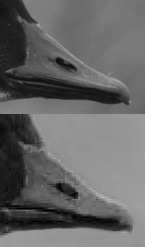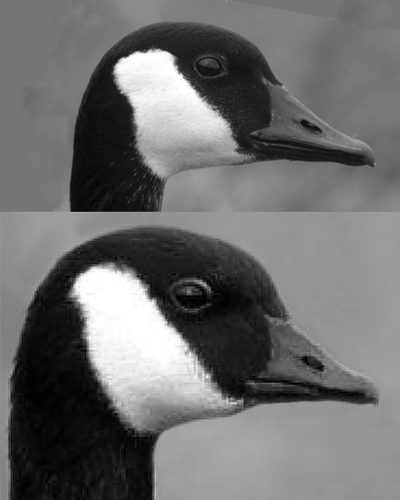
I recently checked the bill length to bill depth ratios of Cackling and Canada Geese, expecting to find a consistent and useful difference. The bills of Cackling Geese are often described as “stubby” and I was always under the impression that they were short and relatively deep. Working with the measurements in Pyle (2008, Identification Guide to North American Birds: Part II) showed that there was virtually no difference in the ratio of length to depth.
For example, length to depth is 1.9 to 1 in Richardson’s Cackling Goose (B. h. hutchinsii), and 2 to 1 in the longest-billed subspecies of Canada Goose (B. c. canadensis). To make matters worse, the measurements given for Lesser Canada Goose show a slightly stubbier bill (1.8 to 1) than Richardson’s Cackling Goose! (On the other hand, the west coast subspecies of Cackling Goose B. h. minima does have a stouter bill than Canada, with length to depth ratio about 1.6 to 1.
I put together the comparison of two birds at right to demonstrate the challenge. It’s possible to detect a slight difference in proportions, but only barely, and I am certain that using a larger sample of photos would show overlap in bill shape.
Below are the same two photos, now showing the entire head. With the head for context, it’s clear which is the Cackling Goose and which is Canada.

There seem to be optical illusions at work that make the bill look stubbier when the whole head of the Cackling Goose is visible, but this exercise shows that bill shape is not a helpful feature when trying to distinguish these species. It would be better to compare bill length to head length (as we do with Greater and Lesser yellowlegs) and perhaps also to compare bill length to neck thickness. Of course, this doesn’t do anything to address the ongoing issue of distinguishing Lesser Canada Goose from Cackling Goose, but at least we know that bill shape is not going to help.


Dave,
Can you use bill length / head width ratios like we do w/ Lesser and Greater Yellowlegs. The head of the Cackler in your photo looks to be about 2X the length of the bill, while only 1.5X longer than the bill on the Canada. Seems to me that it might be useful field mark, but I haven’t tried it w/ other images…
Comments?
Jerry
As far as in the field separation of these two species (or species groups) I have always found overall size to be a very accurate first indicator. Typically outside of the breeding range these birds are found in mixed flocks and it is clear that the proportions of one don’t match the others. Perhaps most telling is the difference in flight action of the two species groups. I find that Cacklers fly almost like a large duck, with a fast, steady wing cadence, while Canadas fly more like a goose, slower, more varied in ‘effort’ and with longer glides coming into landings.
Voice is also a key point, and after spending several seasons working within the breeding range of Taverner’s Cackling Goose I can readily tell the higher pitched, rushed, almost stuttering sound of the Cackling call from the slow deep and resonant honking of the Canada Goose.
I think the photos illustrate a very telling aspect of visual identification though, namely the importance of ‘feel’ or ‘jiss’. I am not suggesting that every bird be identified on such soft characteristics, but more often than not, these soft features can be obvious enough that they will at least single out an individual for more thorough analysis.
From a practical perspective however, I think that learning to develop an eye for ‘jiss’ is one of the most obvious differences that separate good field birders from excellent ones. Just take an off-shore seabird cruise or try going over a large mixed flock of shorebirds between you and the setting sun!
Here in Barron, Wisconsin we have a small resevoir normally filled with three or more different size geese each fall. We watch them almost every day. I am assuming they are the Giant Canada, Lesser Interior Canada and the Richardson. They fly together over our house daily in the fall (not as many this year for some reason) and you can see the difference in sizes. The smaller goose, probably Richardson is about 1/3 the size of the Giant. The lesser Interior about 1/2 to 2/3 the size of the Giants.
We do hunt these geese in the neighboring fields and have bagged all three sizes. The smaller goose has a wing span of only about 18 – 22 inches and not too much bigger than a Mallard. The Giant’s wingspans are more in the 3.5 foot range. The Lesser Canada is about 24 – 30 inch range. When a Richardson is put next to the Giant, there is such a distinct difference. It is wonderous not knowing if the Giant is bigger than life or the smallest goose smaller than life.
We go by the wing span more than anything else as they all look alike when not fully inspecting or knowing the subtle differences. For some people, they are just all Canada Geese.
What subspecies are each of the photos?
Pingback: Are Cackling Geese Rare? – Ploverbirds.com
Pingback: How Many Cackling Goose Are There? – Ploverbirds.com
well done. I appreciate the clear descriptions. I guess I’ll stick to identifying by the calls while flying .